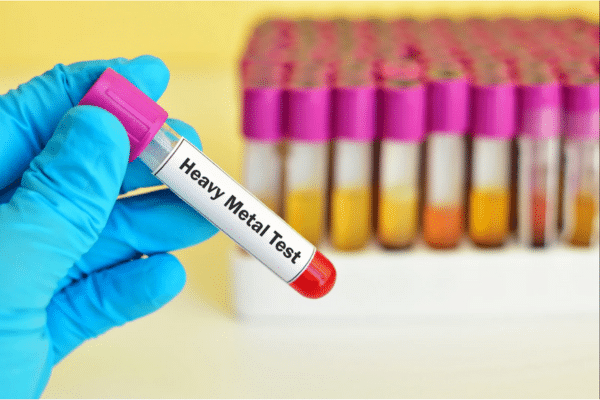Heavy metals are chemicals with high density and high atomic weight. They are widely distributed in the environment due to natural and human activities. Some are essential for biological functions, but others are toxic even at low concentrations, therefore interfering with key cellular processes and affecting well-being.
Today in Epixlife, we will address the main heavy metals that impact the body, how they alter biological functions, and how tools such as epigenetic optimization reports can help assess their effects.
What are heavy metals and why are they important?
Heavy metals are characterized by their high chemical reactivity and their ability to accumulate in living organisms. These elements can be found in natural sources, such as soil minerals. However, human activity has significantly increased their presence in air, water, and food.
Classification:
1. Essential: In small quantities, they are necessary for the cells to function properly.
Examples: zinc, copper,r, and iron.
2. Non-essential and toxic: They are not useful to the body and cause negative effects, such as mercury, le, ad, and cadmium.
Which heavy metals affect well-being?
– Lead (Pb)
Sources of exposure:
– Old paint, contaminated soil, water pipes, and industrial products.
Effects:
Lead interferes with neuronal and enzymatic signaling processes, therefore affecting key functions of the cell. Studies have shown its ability to alter epigenetic patterns through DNA methylation, affecting gene expression in key tissues.
– Mercury (Hg)
Sources of exposure:
– Consumption of large fish (such as tuna and swordfish) and industrial emissions.
Effects:
Mercury generates oxidative stress by producing reactive oxygen species (ROS), damaging cell membranes, proteins, and DNA. It can also deregulate epigenetic processes, negatively impacting cellular adaptive capacity to environmental stimuli.
– Cadmium (Cd)
Sources of exposure:
– Tobacco, phosphate-based fertilizers, contaminated foods such as rice and seafood.
Effects:
Cadmium inhibits essential enzymes by substituting trace elements in their active structures, which alters cell metabolism. It also interferes with DNA methylation, therefore activating genes related to inflammatory processes.
– Arsenic (As)
Sources of exposure:
– Contaminated groundwater, pesticides, and some traditional medicines.
Effects:
Arsenic induces epigenetic modifications through alterations in histones and non-coding RNA expression, affecting gene regulation. It can also increase ROS production, intensifying cell damage.
– Nickel (Ni)
Sources of exposure:
– Contaminated soils, metallurgical industries, and everyday items such as jewelry.
Effects:
Nickel can accumulate in tissues, generating oxidative stress and promoting cellular inflammation. It also affects the epigenetic modifications of histones, altering the transcription of genes involved in cellular repair.
Mechanisms of action of heavy metals
Generation of oxidative stress
Most heavy metals catalyze the formation of reactive oxygen species, which damages proteins, lipids, and DNA. This molecular damage interferes with essential functions such as mitochondrial energy and DNA repair.
Disruption of epigenetic regulation
Heavy metals affect key epigenetic processes, such as:
1. DNA methylation: they inhibit or favor abnormal methylation patterns that alter the expression of genes essential for cellular homeostasis.
2. Histone modifications: They change the chromatin structure, impacting the accessibility of genes to the transcription process.
Enzymatic inhibition
By substituting essential elements such as zinc in critical enzymes, heavy metals reduce the efficiency of key metabolic processes such as protein synthesis or cellular detoxification.
Epigenetic optimization: interference assessment
Epigenetic optimization is an innovative approach that assesses how environmental factors, including heavy metals, impact epigenetic patterns in the organism.
What does the epigenetic optimization report evaluate?
- Presence of heavy metals: Analyzes their accumulation in key tissues and their relationship with alterations in cellular processes.
- Impact on gene regulation: Identifies abnormal DNA methylation patterns and histone modifications.
- Interference in cellular resilience: Evaluates how heavy metals affect the organism’s ability to adapt to environmental challenges.
Benefits of a customized optimization report
– Provides a comprehensive view of environmental interference.
– Offers specific strategies to mitigate the impact of heavy metals.
– Allows the ability to design plans that promote adaptive gene regulation.
Strategies to reduce exposure and mitigate impacts
1. Identification of environmental sources
– Use of water filters to reduce exposure to lead and arsenic.
– Selection of contaminant-free foods, such as small fish and organic crops.
2. Adapted lifestyle
– Avoiding household products containing heavy metals.
– Promoting environments free of industrial pollutants.
3. Interventions based on epigenetics
– Incorporate foods rich in bioactive compounds such as polyphenols and sulfur compounds that influence epigenetic patterns.
– Implement personalized strategies based on the results of the epigenetic optimization report.
Conclusion
Heavy metals represent a major challenge due to their ability to alter fundamental biological processes. Understanding their impact, coupled with the implementation of advanced tools such as epigenetic optimization, allows these interferences to be effectively addressed. By making informed decisions and adopting personalized strategies, it is possible to minimize the negative effects of these elements and promote a more balanced internal environment.

